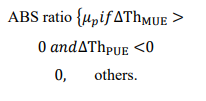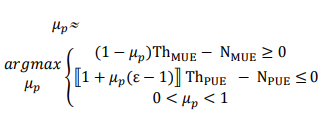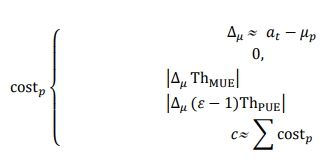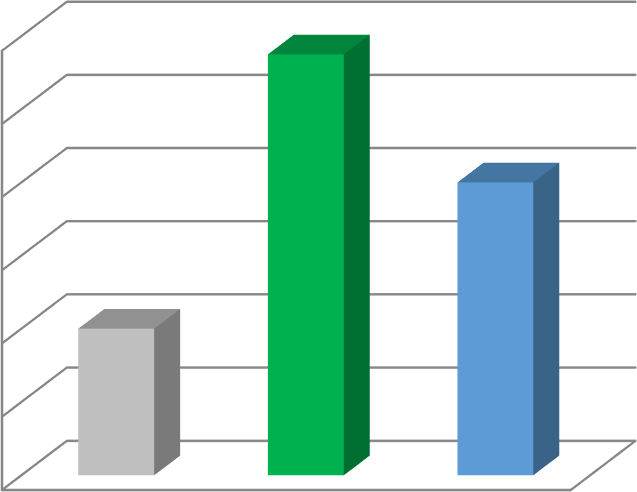HNSJ
Humanities & Natural Sciences Journal
ISSN: (e) 2709-0833
Peer-Reviewed Journal
Indexed at: NSP – SJIF
Arabic Impact Factor 2020 = 0.44
Research Title
DESIGNED AN ADAPTIVE MECHANISM WHICH DYNAMICALLY ADJUSTS THE ABS RATIO ACCORDING TO THE NETWORK CONDITION TO IMPROVE RESOURCE UTILIZATION
Mohammed Farooq Hamdi1 Mudathir A .Fagiri2
Sudan University for Science and Technology
Email: mohammedfarooqhamdi@gmail.com
Sudan University for Science and Technology
Email: ramsarjasfagiri@gmail.com
HNSJ, 2022, 3(7); https://doi.org/10.53796/hnsj3727
Published at 01/07/2022 Accepted at 21/06/2022
Abstract
We propose in 3GPP we designed an adaptive mechanism which dynamically adjusts the ABS ratio according to the network condition to improve resource utilization. scheduling algorithms have been developed and optimised to adapt the proposed scheme for both macro and small cells. It is responsible for the optimum resource allocation to minimise the inter-cell interference to the minimum ranges.
Our simulation results showed that learning-based dynamic ABS scheme was 4. % higher than that of the static ABS scheme. Finally, by integrating the mechanisms of dual connectivity, CRE, and ABS, the QoS satisfaction ratio of cell edge UEs could be improved by 10.76% as compared to the traditional approach.
The proposed scheme demonstrates better performance with less complexity in terms of user and cell throughputs, and spectral efficiency, as compared with the previously employed scheme
The study recommended using the dynamic ABS technique to improve network performance and reduce interference.
Key Words: Dynamic ABS D-(ABS), dual connectivity (CRE), LTE-A, eICIC, intercell interference coordination.
Preface
The time domain-based ICIC schemes basically rely on reducing the transmission activity on certain sub frames by each of the cell layers to minimize interference to the victim layers. These sub frames are indicated as Almost Blank Sub frames (ABS).
An ABS is defined as minimum transmission of sub frames, where zero data signal will be transmitted from the macro cell but only transmit the most critical information required for the system to provide support to legacy LTE (Release 8/9) UEs. Therefore, through ABS, the signals that are primarily sent are common reference signals (CRS) and other required system information. As a result, through sub frames where the macro-cell transmits ABS, the low power small cells are able to schedule UEs from a larger geographical area that else would experience too high interference from the macro layer
ABS technique can improve both cell-edge and cell throughputs as a result of using these protected sub frames by some Pico users as well, where Macro cell keeps silent through these sub frames. Almost Blank Sub frame
The basic idea of the time domain techniques is to mute certain sub frames of some cells in order to reduce the interference to the other cells We call a cell that causes interference to UEs of another cell an aggressor cell and the latter the victim cell; the UEs that are interfered are referred to as the victim UEs. Ideally, the muted subframes configured by an aggressor cell should be totally blank (i.e. all REs are muted) in order to reduce the interference as much as possible.
Dynamic Almost Blank Sub frame:
In order to explore the dual connectivity mechanism combined with CRE and ABS, the ABS configuration learning procedure is introduced in this section. We propose a novel Algorithm dynamic ABS method based on reinforcement learning. Furthermore, it is effective to adjust the ABS ratio and reduce the interference in the co-channel networks by coordinating the adjacent Macro BSs.
Thus, we also propose a centralized decision to adjust the ABS ratio which requires all Macro BSs to synchronize their ABS ratio
Problem Statement
almost blank subframe (ABS) techniques emerge as inter-cell interference mitigation technique in time region. One of the conventional ABS techniques is dynamic ABS assignment, which is able to adapt to interference circumstances to protect the cell-edge users more. In the dynamic ABS assignment method,ABS dynamically allocates ABS to its subframe based on surrounding circumstances. However, the resource utilization of BSs decreases, because the number of ABS assignments increases in the dense BS deployment. This results in low sum rate.
In addition, if the number of ABS assignments increases, user fairness becomes impaired due to the difference of the number
of users which each BS serves. In this paper, we propose a dynamic ABS assignment method with power control subframe
to improve sum rate and user fairness together. Each BS receives feedback from surrounding BSs and users, and chooses its subframe assignment based on the received feedback. Simulation
Aims and Objectives
Improve network performance “increasing throughput” and “load balancing” using optimized number of ABS “Dynamically depends on the network condition”.
Contribution
- ABS taken as a fixed ranges pre-configured in to core network with conditions, in this research a dynamic number of ABS will be configured into the network core.
- Two scenario was done including fixed ABS and dynamic ABS, thus the network performance will be test on the two scenario.
Methodology
In this section, we explain how to utilize ABSs in heterogeneous networks. We consider the following two typical deployment scenarios: –
-
- The macro–Pico deployment scenario:
where the Pico UEs in the CRE region of a Pico cell suffer strong interference from a macro cell
-
- In the macro–Pico deployment scenario:
the expected behaviors of the macro- and Pico cells are described in the following.
Step 1: The macro cell predicts that the traffic demand may exceed its capacity and it has to offload some UEs to the Pico cell.
Step 2: The macro cell hands over some UEs to the Pico cell by employing CRE. Step 3: The macro cell mutes some sub frames by configuring ABS
These subframes are also called “protected sub frames from the context of the Pico cell”.
Step 4: The macro cell informs the Pico cell of the ABS pattern via the X2 interface.
Step 5: The Pico cell schedules those UEs in the protected sub frames, based on the received ABS pattern. It configures its UEs to report channel state information of the protected and non-protected subframes separately as the nature of interference is very different in the two types of sub frames. This principle is called restricted measurements.
The percentage of ABSs configured by the macro cell depends on the CRE bias. In principle, if a large CRE bias is configured, more UEs will be served by the Pico cell and thus a higher ratio of ABSs is desirable.
The CRE bias and ABS ratio need to be optimized jointly to achieve the maximum system throughput.
Evaluation for the E-ICIC of D-ABS Scheme
Simulation Scenario
In this work, we proposed a -based dynamic ABS scheme to learn the appropriate ABS configuration for a global ABS ratio setting. The key idea is inspired from the literature. In the ABS ratio was dynamically adjusted based on the throughput of Macro BS and Pico BS since the UE distribution in each sector of a macro station is die rent, the ABS ratio will also be die rent. Furthermore, the deference in ABS ratios will affect the throughput of each BS. Thus, we can define the deference between the distributions of the throughput as the cost parameter in learning. The agent finally chooses the best ABS ratio when learning is converged to the minimum cost.
The detailed steps of learning-based dynamic ABS scheme consist of two steps:
- It estimates the required ABS ratio in each sector of the Macro station first. Let the total bandwidth requirement of the UEs in Macro BS and Pico BS be NMUE and NPUE,
respectively. Assume that the sum of the throughput allocated by the Macro BS and Pico BS in the previous frame to the UEs is Th _MUE and Th _PUE, respectively. Thus, the deference between the required bandwidth and the actual assigned throughput can be expressed as follows.
Mathematical Model

In order to meet the QoS requirements of the UE, the Equation illustrates the opportunity of using ABS, which contains two conditions.
- The first one is that all of the MUEs must satisfy QoS requirement, and there are remaining resources in the Macro BS (D Th PUE > 0).
- The other one is that some PUEs have not satisfied QoS requirement after resource allocation in pico BS (D ThPUE < 0).
Let the set of Macro BSs be denoted by M. If the above two conditions are met, then we can first give the parameter _p (p 2 M) as the ABS ratio in each sector of the Macro station.


Where: is the gain factor and _p (” U 1) is the ratio of increased data transfer rate of the PUE after using ABS over the original data rate. Through the deference in the throughput and the restriction of the QoS requirement, ABS _b can be calculated by solving the simultaneous inequalities. Equation consists of three conditions:
- The decreased throughput of MUEs will not be less than their required bandwidth (NMUE)
- The increased throughput of PUEs will not be more than their required bandwidth (NPUE)
- The value of _b must be between 0 and 1. The aim is to avoid wasting the resources of the MUE after using ABS.
- : With the ABS _b of each sector of the Macro station, the next step is to learn the unified ABS ratio by learning algorithm. The state, action, and cost of the learning algorithm based on the ABS configuration are defined as follows:
- Agent: The system.
- State: The state is defined as s, which is the satisfaction ratio of PUEs in the system. The satisfaction ratio of PUEs is defined as the number of PUEs whose QoS requirements can be met over the total number of PUEs.
- Action: The action is defined as at, which is the ABS ratio.
- Cost: The cost is defined as c, which is the new calculated throughput of each sector of the Macro BS after using the unified ABS ratio.
The cost c estimates the immediate return incurred due to action at states. The cost function is calculated as:

Where Equation (1) represents the deference before and after adjusting the ABS ratio. In Equation (26), Dµ > 0 indicates that the actual ABS ratio chosen by the system (at) is greater than that of the sector of the Macro BS estimated by it (µb), thus losing the excessive throughput of MUEs. On the contrary, Dµ < 0 indicates that the actual ABS ratio chosen by the system is less than that of the sector of the Macro BS estimated by it, thus losing the expected throughput of PUEs. Finally, the sum of these costs in each sector of the Macro BS is calculated in Equation (3).
Algorithm dynamic ABS
Initialize:
- for each P ∈ M do
- calculate the initial ABS ratio 𝜇𝑝 based on equations (25) and (26) 3 end for
- for each s∈S ,𝛼 ∈ A do
- Initialize the Q-value as the Q (s𝑡,𝛼𝑡) 6 end for
Learning:
- loop
- get the current State s𝑡 ∈ S
- Select the action 𝛼𝑡∈A which has the minimum Q-value 10 calculate ∆𝜇 based on equation (28)
- for each b ∈ M do
- calculate the cost of changing the ABS ratio 𝜇𝑝to 𝛼𝑡 based on equation (28)
- Sum the cost to c based on equation (28) 14 end for
15 observe the next State s𝑡+1 and update the Q table entry as follows:

17 end loop
ABS Static(Normal) Algorithm
Compute the ST ABS:
Where:
BW: Band Width
ST ABS = BW×.05
Table 1 Comparison of Static ABS static and ABS dynamic ABS
| Factor | dynamic ABS scheme | Static ABS scheme |
| Scheduling |
|
|
| ABS Count |
|
According To The Percentage Of Empty Tires Available From The Macro Station (5% In Small Bands Width) |
| Delivery | – System status test (the number of users in the pico who need quality of service divided by the total number of users in the pico | From a macro cell using CRE |
Simulation Results
Table (2) System parameters of the simulation
| Parameter | Configuration |
| Cellular layout | Wrap around,7macros,3sectors per site |
| Carrier frequency | 2.14 GHZ |
| Band width | 10 MHZ |
| ISD | 500 M |
| Macro transmit power | 46 dB |
| Pico transmit power | 30 dB |
| Number of pico per sector | 2 |
| Number of UE per sector | 15 |
| Cell selection | HCI and SINR |
| ABS | Q-learning dynamic and static |
| Thermal noise | -174 dB/Hz |
| UE speed | 3km/hr. |
| Path loss model | As in 3GPP TS 36.942 |
For performance comparison of our proposed schemes, the following simulation scenarios were considered. The purpose of designing the two scenarios is illustrated as follows.
Scenario 1: It is designed to verify the performance of the D-ABS scheme in single connectivity, which is compared with the static ABS scheme.
Scenario 2: It is designed to verify the performance of dual connectivity combined with CRE and ABS
Scenario 1: compares the performance of the dynamic ABS (D-ABS) scheme with that of the static ABS scheme. For the static ABS scheme, the ABS ratio was set to 0.5 according to most of the literature.
Recall that the D-ABS scheme adopts the mechanism to dynamically adjust the ABS ratio according to the feedback of the system.
Two scenarios were simulated; we first simulated the case where more UEs were MUEs. Specifically, the UE population of Macro BS was three times more than that of Pico BS. In the second case, all UEs were evenly distributed.
Figure (1) presents that the system QoS satisfaction ratio of the D-ABS scheme was 4. % higher than that of the Static ABS scheme in the first scenario. In the second scenario where UEs were evenly distributed, the proposed D-ABS scheme was still better (7%) than the static ABS scheme, as shown in Figure (1).

50%
48%
46%
44%
Non ABS
Dynamic ABS static ABS= 0.5
42%
40%
38%
Non ABS
Dynamic ABS static ABS= 0.5
Figure (1): Optimized ratio of the different enhanced inter-cell interference coordination (e-ICIC) Schemes in the overload situation of the Macro BS
![]()
![]()
![]()
![]()
![]()
![]()
![]()
![]()
![]()
Figure (3): Compare between static & dynamic ABS
Scenario 2: Evaluation for the Combined with CRE and ABS:
Both the dual connectivity and the e-ICIC can improve the performance of the UE at the edge of BSs. For this reason, we propose a comprehensive scheme to explore the feasibility of combining the dual connectivity with CRE and ABS, and evaluate whether it can effectively improve the QoS bandwidth requirements of edge UEs via a scenario 2 simulation. Since the comprehensive scheme is based on the connection mode, cell selection, resource allocation, e- ICIC, and CRE bias, we compared its performance with individual schemes, including non- ABS and Static ABS, and dynamic ABS.
In this scenario, we focused on the dual connectivity mode. With CRE and ABS did not yield better system QoS satisfaction, but it was useful to increase the QoS satisfaction of edge UEs. Figure (3) shows the QoS satisfaction of deferent combinations of schemes, UEs in CRE region are referred to as cell edge UEs. We can observe from Figure (3) that by integrating the
mechanisms of interference management, CRE, and ABS, the QoS satisfaction ratio of cell edge UEs can be improved by 10.76% as compared to the traditional approach.
CRE ABS
60%
50%
40%
30%
20%
10%
0%
NON ABS
Dynamic ABS
Static ABS = 0.5
Figure (3)
Conclusion
For heterogeneous network research, WE propose the D-ABS scheme to adjust the ABS ratio dynamically according to system feedback.
Our simulation results showed that learning-based dynamic ABS scheme was 4. % higher than that of the static ABS scheme. Finally, by integrating the mechanisms of dual connectivity, CRE, and ABS, the QoS satisfaction ratio of cell edge UEs could be improved by 10.76% as compared to the traditional approach.
In this project the almost blank subframe (ABS) which are a part of Enhanced Inter-Cell Interference Coordination (eICIC) framework that was developed by the 3GPP. The 3GPP develop two major methods in the time domain ABS and RP-ABS, after study and investigation of these methods it was found that in the normal ABS a blank frames is send so a reduce in the throughput of the system can be the result, and at the RP-ABS a fixed power is used in the Subframes so it can effected by the signal to noise ratio SNR at a specific moment. The study recommended using the dynamic ABS technique to improve network performance and reduce interference
Reference
- S. Padmapriya, M. Tamilarasi, “A case study on femtocell access modes “, Engineering Science and Technology, an International Journal (Sept. 2016).
- D. Siswanto, L. Zhang, K. Navaie, “Spectrum Splitting-Based Cognitive Interference Management in Two-Tier LTE Networks”, International Symposium on Wireless Communications Systems,(Nov. 2014).
- Erik Dahlman, Stefan Parkvall and Johan Skold, 4G: LTE/LTEAdvanced for Mobile Broadband, Elsevier ltd, (Jan.2011).
- B. Clerckx, A. Lozano, S. Sesia, C. v. Rensburg, and C. B. Papadias, 3GPP LTE and LTE- Advanced, Hindawi Publishing Corporation EURASIP Journal on Wireless Communications and Networking , (Sept. 2009).
- M.A. Gadam, L. Maijama‟a, I.H. Usman, “A REVIEW OF RESOURCE ALLOCATION TECHNIQUES FOR THROUGHPUT MAXIMIZATION IN DOWNLINK LTE”, Journal of Theoretical and Applied Information Technology 20th December 2013.
- F. Richard Yu, Vincent W.S Wong and Victor C.M, “A new QOS provisioning method for adaptive multimedia in wireless networks”, IEEE transactions on vehicular technology, May 2008.
- M. Viswanathan, simulation of digital communication system using Matlab book]-second Edition , Feb.18.2013.
- F.E.AbdElsamie, F. S.Alkamali, A. Y. Alnahari and Moawad I. Dessouky, SC-FDMA for mobile communication, Taylor and Francis group,(2014).
- M. Assaad, “Optimal fractional frequency reuse (FFR) in Multi-cellular OFDMA System”, in Proc. IEEE VTC‟, Sept. 2008.
- E. Dahlman, S. Parkvall and J. Skold,”4G LTE/LTE-Advanced for Mobile Broadband”, Elsevier Ltd, 2011.
- J. G. Andrews, “Interference cancellation for cellular systems: a contemporary overview”, IEEE Wireless Communications, vol. 12, no. 2, pp. 19–29, April 2005.
- S. Das, S. Senp. Agrawal and R. jayaram, “A Distributed load balancing algorithm for the hot cell problem in cellular mobile network”, proceeding of 6th IEEE international symposium on high performance distributed computing, 1997.
- D. Lopez-Perez, A. Valcarce, G. De La Roche, and J. Zhang, “OFDMA femtocells: a roadmap on interference avoidance”, IEEE Communications Magazine, Sep. 2009.
- Gwo-Jong Yu and Hoai Nam Bui Khac,” A Novel Downlink Interference Management Mechanism for Two-Tier OFDMA Femtocell Networks”, Journal of Advances in Computer Networks, June 2016.
- Harald Burchardt,” Interference Management in Wireless Cellular Networks”, May 2013.
- Gupta, Prakash C (2006),” Data Communications and Computer Networks”, 10 July 2011
- G. Miao, J. Zander, K-W Sung, and B. Slimane, Fundamentals of Mobile Data Networks, Cambridge University Press, ISBN 110714(2016).
- B. Vidya Sagar, Dr.R.Madhu, S.Ramesh, T.Gopi Sai Krishna,” Path loss and Outturn analysisof LTE-A Femtocells under Co-Channel Interference using Dynamic schemes” Department of ECE, India, 2016.
- Shahram Zarei, ”channel coding and link adaptation ”, Sep. 2009.
- Z. Bharucha, A. Saul, G. Auer, and H. Haas, “Dynamic Resource Partitioning for Downlink Femto-to-Macro-Cell Interference Avoidance,” EURASIP Journal on Wireless Communications and Networking, vol. 2010, Article ID 143413, 12 pages, 2010. doi:10.1155/2010/143413.
- S. Rangam, “Femto-Macro Cellular Interference Control with Subband Scheduling and Interference Cancelation,” arXiv:1007.0507v2, Jul. 2010.
- H. Claussen, “Performance of macro- and co-channel femtocells in a hierarchical cell structure,” in Proceedings of the 18th IEEE International Symposium on Personal, Indoor and Mobile Radio Communications (PIMRC ‟07), pp. 1 5, Athens, Greece, Sep. 2007.
- V. Chandrasekhar, and J. G. Andrews, “Spectrum allocation in twotier networks”, 42th Asilomar Conference on Signals, Systems and Computers, pp. 1583-1587, 26 – 29 Oct., 2008.
- CEWiT, “Cognitive Interference Management for Femto-Macro Scenarios”, R1-104106, 3GPP RAN1, TSGR1-61b.
25 .S. Kaimaletu, R. Krishnan, S. Kalyani, N. Akhtar, and B. Ramamurthi, “Cognitive interference management in heterogeneous femto-macro cell networks”, in Proc. of IEEE ICC, pp. 1–6, 2011.
Equation Reference
- 3GPP, “Evolved Universal Terrestrial Radio Access (E-UTRA) and Evolved Universal Terrestrial Radio Access (E-UTRAN); Overall description; Stage 2,” 3rd Generation Partnership Project (3GPP), TS 36.300 v10.11.0, Sep. 2013.
- Y. Wang and K. I. Pedersen, “Performance analysis of enhanced inter-cell interference coordination in LTE-Advanced heterogeneous networks,” in Vehicular Technology Conference (VTC Spring), 2012 IEEE 75th. IEEE, 2012, pp. 1–5.
- K. I. Pedersen, Y. Wang, B. Soret, and F. Frederiksen, “eICIC Functionality and Performance for LTE HetNet Co-Channel Deployments,” in Vehicular Technology Conference (VTC Fall), 2012 IEEE. IEEE, 2012, pp. 1–5.
- M. Shirakabe, A. Morimoto, and N. Miki, “Performance evaluation of inter-cell interference coordination and cell range expansion in heterogeneous networks for LTE-Advanced downlink,” in Wireless Communication Systems (ISWCS), 2011 8th International Symposium on. IEEE, 2011, pp. 844–848.
- J. Pang, J. Wang, D. Wang, G. Shen, Q. Jiang, and J. Liu, “Optimized time-domain resource partitioning for enhanced inter-cell interference coordination in heterogeneous networks,” in Wireless Communications and Networking Conference (WCNC), 2012 IEEE. IEEE, 2012, pp. 1613–1617.
- A. Bedekar and R. Agrawal, “Optimal muting and load balancing for eICIC,” in Modeling & Optimization in Mobile, Ad Hoc & Wireless Networks (WiOpt), 2013 11th International Symposium on. IEEE, 2013, pp. 280–287.
